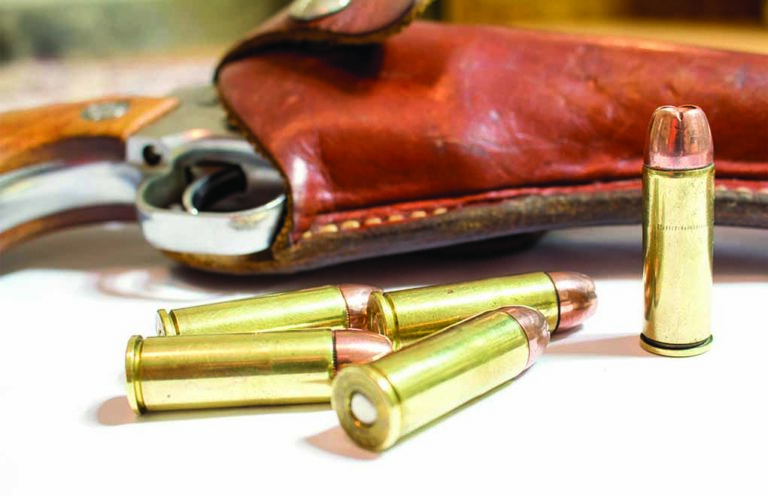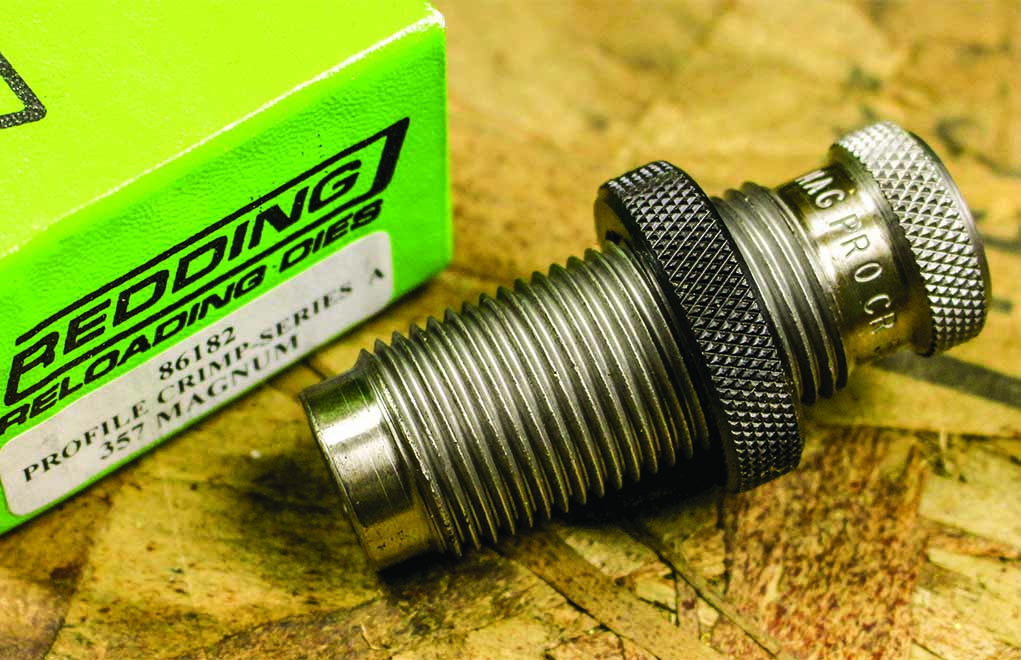
Follow these guidelines reloading revolver cartridges for maximum performance, reliability and safety.
Keys To Reloading Revolver Cartridges:
- Style of bullet dictates style of crimp.
- Research your revolver–make, model, date of manufacturer–to build a clear idea of its limitations.
- Don't exceed these limits hot-rodding, thus potentially damage the cylinder and frame.
I’ve been a wheelgun guy since I was a kid. My dad taught me how to shoot with that Ruger Single Six he wore on his gun belt each night he’d take the ’coon hounds out in the fall. How many raccoons fell to that pistol even he can’t estimate.
As my friends and I got older and began to acquire our own handguns (they were primarily wheelguns) and subsequently began to handload for them, we learned an awful lot about what to do and what not to do.
When it comes to reloading for revolvers, there are a few guidelines that’ll help keep you—and your gun—healthy and running properly.
Revolver Cartridges And Crimp
Most revolver cartridges are rimmed cartridges. That’s important, because it gives the handloader some flexibility in their approach, especially regarding different crimp styles. Where the straight-walled pistol cartridges that work so well in the auto-loading handguns require a good, clean and square case mouth for proper headspacing, the rim of revolver cartridges handles the headspacing duties. This leaves some options for the case mouth: Depending on the bullet you’ve chosen, you can work it a few ways, but you’ll certainly need to use a crimp of some type for all revolver ammunition.
The most popular means of keeping things put is the roll crimp, for which the mouth of the case is physically rolled into a crimping groove, or “cannelure.” I like this method and prefer it over any other for fast, hard-kicking cartridges. If you were to skip the crimp on a .454 Casull or .44 Remington Magnum, for example, you run the risk of having your bullets “pull” or “pull crimp,” extending outward from their original seating depth under recoil. Should this happen, the projectiles can (and will) move so far outward that they’ll prevent the cylinder from rotating, thereby creating quite a mess.
The Roll Crimp
A roll crimp is obtained from the seating die, because there’s a small shelf located inside the die body. When the die is set low enough, the cartridge case mouth is pressed against this shelf, rolling the mouth inward into the groove in the bullet and locking the two components together.

Don’t worry: Upon ignition, that crimp (and, for that matter, the case walls) will be blown out immediately, being expanded to the chamber dimension. A roll crimp will not only prevent the projectile from moving, it’ll also help even out your velocities.
However, too much crimp can actually damage a bullet, so it’s one of those “Goldilocks” situations: You need just enough crimp to do the job, but not too much; it needs to be just right. The most important thing to remember is to start with a uniform case length. If you don’t have a consistent case length, the amount of crimp will vary accordingly.
I like the RCBS Case Prep Station for its trimmer, which can easily be dialed in to give a precise case length. Redding makes a great crimp die—the Profile Crimp Die—which is designed to put a more uniform crimp than a seating die will and is to be used after the bullet is seated. Pick a case length (some like the SAAMI spec; some like it a bit shorter in order to be able to trim new cases) and then set your seating die for a proper roll crimp … unless you’re using a bullet with no cannelure.
The Taper Crimp
On a bullet with no groove, you’ll have to use a taper crimp, which squeezes the sides of the case body tightly against the bullet to give proper pressure. It’s almost like neck tension for a case with no neck. There’s nothing wrong with this method; in fact, I know folks who use it in conjunction with a stiff roll crimp—as long as it keeps your projectiles where they need to be.
You’ll need to flare your case mouths before seating a bullet. And, to extend case life, I don’t try to over flare. Just open that mouth enough to seat your bullet without crumpling the case wall. You’ll see a longer case life, because the brass isn’t being overworked.

Because we aren’t concerned with the way the cartridge will feed from a magazine, the bullet profile and the way it interacts with the feed ramp become non-issues. Wadcutters, semi-wadcutters, flat nose, round nose, hollow point—all will perform wonderfully in a revolver.
We can also abandon the concern of whether or not the ammunition will cycle an action: Because the cylinder is manually rotated, either by cocking the hammer of a single-action or via the trigger squeeze of a double-action, the lightest loads will perform safely.
I can load my Ruger Blackhawk .45 Colt to run with the lightest 180- and 200-grain lead bullets. Yet, the same gun will handle a 300-grain Hornady XTP Mag or 325-grain Swift A-Frame heavy handgun and can run the spectrum of powder—from TiteGroup and Lil’ Gun to H110 and BlueDot. The heavier loads will certainly provide some substantial muzzle jump. But, as long as you hang onto it, the handgun will perform.
Revolver Cartridge Load Development
And maybe now is a good time to talk about load development, because I’ve seen some guys try to turn a .44 Special into a .44 Magnum or a .38 Special into a .357 Magnum. Beating the snot out of a handgun, trying to get it to be something it isn’t, is a lousy idea.
I have a little Smith & Wesson Model 36—a classic .38 Special snub-nose—and the temptation to run it into the red when I first got it was certainly there. However, the beauty of the little gun is in its size and the ability to conceal it. It isn’t a .357 Magnum, and it’s not even a +P .38 Special. And when I load for it as it’s supposed to be (the gun loves the 158-grain Hornady XTPs at a suitable velocity), it’s a pleasure to shoot. Trying to make a “silk purse out of a sow’s ear,” as my late mother would say, can result in cracked cylinders, stuck cases, jammed-up actions, and other catastrophic results.

Before you begin reloading revolver cartridges do a bit of research about its make, model, and even its date of manufacture, because all of these can play a role in the pressure limits that particular gun can handle. Reloading for your revolver will invariably allow you to shoot it more. As a result, you’ll become more proficient with that gun.
Roll your own for hunting season, and you might just find a new passion.
Editor's Note: This article originally appeared in the September 2020 issue of Gun Digest the Magazine.
Take A Spin With More Revolver Content:
- Civil War’s Unique LeMat Revolver
- 5 9mm Revolver Options Sized Right For Everyday Carry
- Smith & Wesson’s Most Famous Top-Break: The Schofield Revolver
- Double-Action vs. Single-Action Revolvers: Which One is Right for You?
- Best Revolver Reviews To Help Pick The Right Wheelgun
- Shooting the Snubnose Revolver
- The Lost Art Of Shooting Cap-And-Ball Revolvers
- Nagant Revolver: Unique Relic From Behind The Iron Curtain

Next Step: Get your FREE Printable Target Pack
Enhance your shooting precision with our 62 MOA Targets, perfect for rifles and handguns. Crafted in collaboration with Storm Tactical for accuracy and versatility.
Subscribe to the Gun Digest email newsletter and get your downloadable target pack sent straight to your inbox. Stay updated with the latest firearms info in the industry.

![Best Concealed Carry Guns In 2025 [Field Tested] Wilson Combat EDC X9S 1](https://gundigest.com/wp-content/uploads/Wilson-Combat-EDC-X9S-1-324x160.jpg)


![Best 9mm Carbine: Affordable PCCs [Tested] Ruger Carbine Shooting](https://gundigest.com/wp-content/uploads/Ruger-Carbine-Shooting-100x70.jpg)
![Best AR-15: Top Options Available Today [Field Tested] Harrington and Richardson PSA XM177E2 feature](https://gundigest.com/wp-content/uploads/Harrington-and-Richardson-PSA-XM177E2-feature-100x70.jpg)
